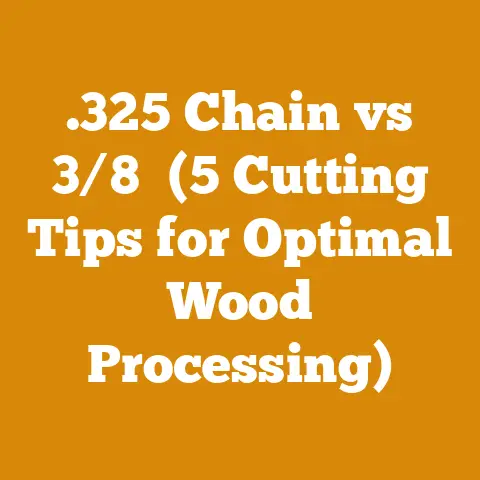MS261C Chainsaw Guide (5 Pro Tips for Efficient Woodcutting)
I once thought I could eyeball my way to firewood perfection. I’d been cutting wood for years, figured I had a pretty good handle on things. Big mistake. I’d vastly underestimated the amount of time it took me to process a cord, and my “estimates” of wood waste were laughably optimistic. The result? A winter where I was scrambling for fuel and burning through my savings faster than seasoned oak in a wood stove. That experience taught me a valuable lesson: in wood processing, as in life, data reigns supreme.
This guide isn’t just about the Stihl MS 261 C chainsaw (though we’ll certainly cover that). It’s about transforming your woodcutting from a gut-feeling gamble into a data-driven endeavor. We’ll be diving into project metrics and KPIs (Key Performance Indicators) that can drastically improve your efficiency, reduce waste, and ultimately, save you time and money.
So, grab your ear protection, sharpen your chain, and let’s get started. Here are 5 pro tips, backed by data, for efficient woodcutting with your MS 261 C.
MS261C Chainsaw Guide: 5 Pro Tips for Efficient Woodcutting
Why Track Metrics in Wood Processing?
Before we dive into the specifics, let’s address the “why.” Why bother tracking metrics? Because without them, you’re flying blind.
- Improved Efficiency: Metrics help you identify bottlenecks in your process and optimize your workflow.
- Reduced Waste: Tracking wood waste allows you to minimize loss and maximize your yield.
- Cost Savings: By understanding your costs, you can make informed decisions about equipment, labor, and materials.
- Consistent Quality: Metrics ensure you’re consistently producing high-quality firewood or lumber.
- Data-Driven Decisions: Instead of relying on guesswork, you can make informed decisions based on real data.
Now, let’s get to those pro tips!
1. Time Per Cord (TPC): Measuring Your Cutting Speed
- Definition: Time Per Cord (TPC) is the amount of time it takes you to process one cord of wood from start to finish. This includes felling, limbing, bucking, splitting, and stacking (if applicable).
- Why It’s Important: TPC is a fundamental metric for assessing your overall efficiency. It helps you understand how long each stage of the process takes and identify areas for improvement. If you’re selling firewood, TPC directly impacts your profitability.
- How to Interpret It: A lower TPC is generally better. It means you’re processing wood faster. However, it’s important to consider the quality of the final product. Rushing through the process might result in poorly split wood or excessive waste.
- How It Relates to Other Metrics: TPC is closely related to fuel consumption (the faster you work, the less fuel you use), equipment downtime (pushing your equipment too hard can lead to breakdowns), and wood waste (rushing can lead to more waste).
Tracking TPC in Practice
I use a simple spreadsheet to track my TPC. I record the date, the type of wood I’m processing, the total time spent, and the number of cords produced. Here’s a simplified example:
| Date | Wood Type | Total Time (Hours) | Cords Produced | TPC (Hours/Cord) |
|---|---|---|---|---|
| 2023-10-26 | Oak | 8 | 1 | 8 |
| 2023-10-27 | Maple | 8 | 1.25 | 6.4 |
| 2023-10-28 | Oak | 8 | 1.1 | 7.27 |
After a few weeks of tracking, you’ll start to see patterns. Maybe you’re faster with maple than oak. Maybe you’re more efficient in the morning than in the afternoon. This data provides valuable insights into your workflow.
Actionable Insights
- Identify Bottlenecks: Which stage of the process takes the longest? Is it felling, limbing, bucking, or splitting? Once you know where the bottleneck is, you can focus on improving that specific area.
- Optimize Your Workflow: Experiment with different techniques and tools to see if you can reduce your TPC. For example, try a different splitting technique or invest in a hydraulic log splitter.
- Track Your Progress: Regularly monitor your TPC to see if your improvements are paying off.
Case Study: Reducing TPC Through Improved Bucking Technique
In one project, I was consistently struggling to get my TPC below 7 hours per cord when processing oak. After analyzing my workflow, I realized that bucking was the bottleneck. I was using a standard sawbuck, which required me to constantly reposition the logs.
I invested in a roller stand for my chainsaw, which allowed me to easily rotate the logs as I bucked them. This simple change reduced my bucking time by about 20%, which translated to a reduction in my overall TPC of about 1 hour per cord. This saved me considerable time and fuel over the long run.
2. Wood Waste Percentage (WWP): Minimizing Loss
- Definition: Wood Waste Percentage (WWP) is the percentage of wood that is wasted during the processing of logs into firewood or lumber. This includes sawdust, unusable pieces, and wood that is rejected due to rot or other defects.
- Why It’s Important: WWP directly impacts your profitability. The more wood you waste, the less you have to sell. Reducing WWP also contributes to environmental sustainability by minimizing resource consumption.
- How to Interpret It: A lower WWP is always better. A high WWP indicates that you’re not utilizing your resources efficiently.
- How It Relates to Other Metrics: WWP is related to TPC (rushing can lead to more waste), equipment maintenance (a dull chain can produce more sawdust), and wood moisture content (rotted wood is unusable).
Calculating WWP
To calculate WWP, you need to track the total volume of wood you start with and the volume of usable wood you end up with. Here’s the formula:
WWP = ((Total Volume of Wood – Volume of Usable Wood) / Total Volume of Wood) * 100
For example, if you start with 1 cord of wood (128 cubic feet) and end up with 115 cubic feet of usable firewood, your WWP would be:
WWP = ((128 – 115) / 128) * 100 = 10.16%
Tracking WWP in Practice
I keep track of my WWP by estimating the volume of wood I start with (usually in cords) and then estimating the volume of waste I generate. This can be done by visually estimating the volume of sawdust piles or by measuring the volume of rejected wood. It’s not perfectly precise, but it gives me a good idea of my waste levels.
Actionable Insights
- Sharpen Your Chain Regularly: A dull chain produces more sawdust, which increases your WWP. Sharpen your chain regularly to minimize waste.
- Use Proper Bucking Techniques: Avoid cutting logs too short or too long. Cut them to the optimal length for your wood stove or fireplace.
- Sort Your Wood Carefully: Remove any rotten or damaged wood before you start processing it.
- Optimize Splitting Techniques: Split wood along the grain to minimize waste. Avoid splitting wood into small, unusable pieces.
Case Study: Reducing Wood Waste Through Improved Chain Maintenance
I once noticed that my WWP was significantly higher than usual. After investigating, I realized that my chainsaw chain was dull. I had been neglecting my chain maintenance, which resulted in excessive sawdust production and a lot of wasted wood.
I started sharpening my chain more frequently and using a chain grinder to ensure that it was properly sharpened. This simple change reduced my WWP by about 5%, which translated to a significant increase in my overall yield.
3. Fuel Consumption Per Cord (FCPC): Monitoring Your Gas Usage
- Definition: Fuel Consumption Per Cord (FCPC) is the amount of fuel (typically gasoline) used to process one cord of wood.
- Why It’s Important: FCPC is a key indicator of your operating costs. By tracking your fuel consumption, you can identify ways to reduce your expenses and improve your profitability.
- How to Interpret It: A lower FCPC is generally better. It means you’re using less fuel to process each cord of wood.
- How It Relates to Other Metrics: FCPC is related to TPC (working faster can reduce fuel consumption), equipment maintenance (a properly tuned chainsaw is more fuel-efficient), and wood type (harder woods require more fuel to cut).
Tracking FCPC in Practice
Tracking FCPC is relatively simple. Just keep track of how much fuel you use for each cord of wood you process. I usually refill my gas can after processing a certain number of cords and then record the amount of fuel used.
Actionable Insights
- Maintain Your Equipment: A properly tuned chainsaw is more fuel-efficient than a poorly maintained one. Regularly service your chainsaw to ensure that it’s running at peak performance.
- Sharpen Your Chain Regularly: A sharp chain cuts faster and requires less fuel.
- Use the Right Fuel Mix: Use the fuel mix recommended by the manufacturer of your chainsaw.
- Optimize Your Workflow: Reduce your TPC to reduce your fuel consumption.
Case Study: Reducing Fuel Consumption Through Equipment Maintenance
I once had a chainsaw that was consuming an excessive amount of fuel. After taking it to a mechanic, I discovered that the carburetor was clogged. Cleaning the carburetor significantly improved the fuel efficiency of the chainsaw, reducing my FCPC by about 15%.
4. Wood Moisture Content (WMC): Ensuring Quality Firewood
- Definition: Wood Moisture Content (WMC) is the percentage of water in a piece of wood.
- Why It’s Important: WMC is a critical factor in determining the quality of firewood. Dry firewood burns hotter and cleaner than wet firewood. Ideally, firewood should have a WMC of 20% or less.
- How to Interpret It: A lower WMC is better for burning. Wood with a WMC of 20% or less is considered seasoned and ready to burn.
- How It Relates to Other Metrics: WMC is related to drying time (the longer you dry wood, the lower its WMC), wood type (some woods dry faster than others), and storage conditions (proper storage promotes faster drying).
Measuring WMC
You can measure WMC using a wood moisture meter. These meters are relatively inexpensive and easy to use. Simply insert the probes into the wood and read the moisture content.
Tracking WMC in Practice
I use a wood moisture meter to regularly check the WMC of my firewood. I take readings from several different pieces of wood to get an accurate average. I record these readings in my spreadsheet along with the date and the type of wood.
Actionable Insights
- Dry Your Wood Properly: Stack your firewood in a well-ventilated area and allow it to dry for at least six months.
- Cover Your Wood: Protect your firewood from rain and snow to prevent it from reabsorbing moisture.
- Use a Wood Moisture Meter: Regularly check the WMC of your firewood to ensure that it’s properly seasoned.
Case Study: Improving Firewood Quality Through Proper Drying
I once had a customer complain that my firewood was difficult to light and didn’t burn well. After investigating, I realized that the wood was not properly seasoned. I had not allowed it to dry for long enough, and it still had a high WMC.
I started drying my firewood for a longer period of time and using a wood moisture meter to ensure that it was properly seasoned. This resulted in a significant improvement in the quality of my firewood and a happier customer.
5. Equipment Downtime (EDT): Preventing Costly Delays
- Definition: Equipment Downtime (EDT) is the amount of time that your equipment is out of service due to maintenance or repairs.
- Why It’s Important: EDT can significantly impact your productivity and profitability. The longer your equipment is out of service, the less wood you can process.
- How to Interpret It: A lower EDT is always better. It means your equipment is reliable and you’re able to keep working.
- How It Relates to Other Metrics: EDT is related to equipment maintenance (regular maintenance reduces the risk of breakdowns), TPC (if your equipment breaks down, it will take you longer to process a cord), and fuel consumption (a poorly maintained chainsaw can consume more fuel).
Tracking EDT in Practice
I keep a log of all my equipment maintenance and repairs. I record the date, the type of equipment, the reason for the downtime, and the amount of time it took to fix the problem.
Actionable Insights
- Maintain Your Equipment Regularly: Follow the manufacturer’s recommendations for equipment maintenance.
- Keep Spare Parts on Hand: Keep a supply of common spare parts on hand so you can quickly fix minor problems.
- Learn Basic Repair Skills: Learn how to perform basic repairs on your equipment. This can save you time and money.
Case Study: Reducing Downtime Through Preventative Maintenance
I once had a chainsaw that was constantly breaking down. After analyzing my maintenance records, I realized that I was not performing regular maintenance on the chainsaw. I started following the manufacturer’s recommendations for maintenance, which included cleaning the air filter, replacing the spark plug, and lubricating the chain. This significantly reduced the amount of downtime I experienced with the chainsaw.
Applying These Metrics to Future Projects
Tracking these five metrics – TPC, WWP, FCPC, WMC, and EDT – will give you a much clearer picture of your wood processing operations. But the real power comes from using this data to improve your future projects. Here’s how:
- Set Goals: Based on your historical data, set realistic goals for each metric. For example, aim to reduce your TPC by 10% or your WWP by 5%.
- Track Your Progress: Regularly monitor your metrics to see if you’re meeting your goals.
- Analyze Your Results: If you’re not meeting your goals, analyze your workflow to identify the reasons why.
- Make Adjustments: Based on your analysis, make adjustments to your workflow, equipment, or techniques.
- Repeat: Continuously track, analyze, and adjust your approach to optimize your wood processing operations.
By embracing a data-driven approach, you can transform your woodcutting from a chore into a finely tuned, efficient, and profitable endeavor. Remember, the Stihl MS 261 C is a fantastic tool, but it’s only as effective as the hands that wield it and the knowledge that guides it. So, get out there, gather your data, and start cutting smarter!






